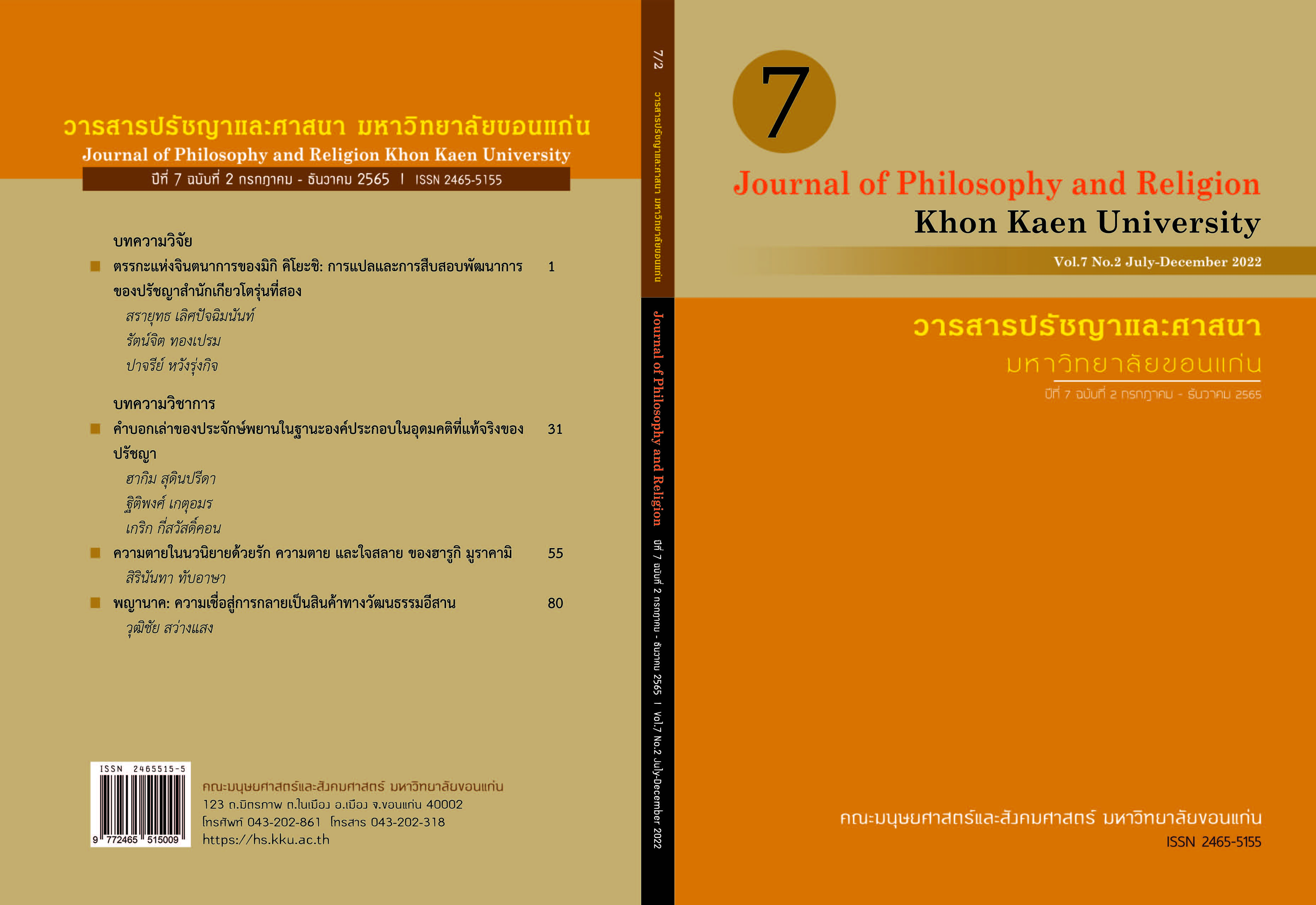ความตายในนวนิยายด้วยรัก ความตาย และใจสลาย ของฮารูกิ มูราคามิ Death in the Norwegian wood of Haruki Murakami
Main Article Content
Abstract
บทคัดย่อ
บทความนี้ผู้ศึกษาได้ศึกษาความตายในงานเขียน ด้วยรัก ความตาย และหัวใจสลาย ของ ฮารุกิ
มูราคามิ มีวัตถุประสงค์เพื่อศึกษาแนวความคิดเรื่องความตายในนวนิยาย ด้วยรัก ความตาย และหัวใจสลาย และเปรียบเทียบแนวความคิดของตัวละครหลัก แม้ว่าจะเป็นประเทศในกลุ่มร่ำรวยแต่กลับมีอัตราการฆ่าตัวตายที่สูงคิดโดยเฉลี่ยมีการฆ่าตัวตายอยู่ที่ 70 คนต่อวัน อะไรคือปัจจัยอันมีผลเป็นสิ่งเร้าในปรากฏการณ์เช่นนี้ ซึ่งมิอาจปฏิเสธได้ว่าปัจจัยภายในอันเป็นโลกทัศน์นั้นมีผลต่อการตัดสินใจโดยตรง เป็นสิ่งที่ไม่ควรละเลยการศึกษาครั้งนี้จึงเลือกศึกษาปรากฏการณ์ที่นำเสนอในงานเขียน ใช้วิธีการศึกษาวรรณกรรมในแนวดิ่ง (close reading) เพื่อค้นหาแนวคิดเรื่องความตายในนวนิยาย ด้วยรัก ความตาย และหัวใจสลาย ของฮารูกิ มูราคามิ ศึกษาโดยการมองรายละเอียดการนำเสนอแนวคิด อารมณ์ และตัวละครหลักในเรื่องที่มีประสบการณ์ทางอ้อมกับความตาย เช่น วาตานาเบะ, นาโอโกะ, มิโดริ และเรโกะ
การศึกษาพบว่า ตั้งแต่ช่วงยุคเมจิเป็นต้นมา โลกทัศน์ของชาวญี่ปุ่นมีลักษณะของการกระทบกันทางด้านความคิดอยู่เสมอ ๆ และเกิดจากปัจจัยหลายด้าน ไม่ว่าจะเป็นศาสนาพื้นเมือง ศาสนาชินโต ศาสนาพุทธ ลัทธิเต๋า ลัทธิขงจื่อ รวมกระทั่งถึงปรัชญาแบบตะวันตก และปรัชญาขงจื่อใหม่ ที่รวมเอาแนวคิดแบบตะวันตกและตะวันออกเข้ามาอธิบายแนวคิดทางปรัชญา จากความไหลเข้าทางความคิดนี้ส่งผลให้ชาวญี่ปุ่น ต้องปรับตัวให้เข้ากับกลุ่มแนวคิดที่หลากหลาย จนเกิดภาวะกระอักกระอ่วนใจ และพยายามถ่ายทอดความรู้สึกนั้นผ่านงานเขียน และในงานเขียนชิ้นนี้ได้นำเสนอโลกทัศน์ของความตายที่ส่งผ่านออกมาอย่างแตกต่างกันของตัวละครทั้ง 3 คน ได้แก่ นาโอโกะ เป็นภาพของคนที่ไม่อาจก้าวข้ามความทุกข์จากการมีประสบการณ์ของความสูญเสีย ส่วนมิโดริ เป็นภาพของคนที่มองว่าความตายไม่ได้ต่างจากการเดินทาง ส่วน
วาตานาเบะ เป็นเสมือนตัวแทนของผู้ที่อยู่ตรงกลางแนวคิดมองความตายเป็นทั้งความกลมกลืนของชีวิต
คำสำคัญ : ความตาย, วรรณกรรม, สังคมญี่ปุ่น
Abstract
In this article, researchers studied death in Haruki Murakami's writing about love, death, and heartbreak. The purpose of this article is to study the notions of death and compare them with the concepts of the main characters. Even though the country is rich, the average suicide rate is 70 people per day. Although external factors are triggered by a variety of pressures, it cannot be denied that internal factors have a direct influence on decision-making. This study used the approach of closed reading to find the idea of death in the novel by studying the presentations of ideas and emotions and the main characters in the story who have indirect experiences with death, such as Watanabe, Naoko, Midori, and Reiko.
Studies have found that since the Magic period, Japanese concepts have always been characterized by conflicting ideas and originated from a wide range of aspects, including native religions, Shinto, Buddhism, Taoism, Western philosophy, and new philosophies that incorporate Western and Eastern concepts to describe philosophical concepts. From this influx of ideas, the Japanese people have adapted to a wide variety of concepts until excitement arises and have tried to convey those feelings through writing. And in this work they have presented a worldview of the different passages of the three characters, This influx of ideas resulted in the Japanese having to adapt to a diverse set of concepts. Until the state of embarrassment and try to convey that feeling through writing. And in this writing, the perspective of death is presented differently for the three characters, including Naoko, as a picture of someone who cannot overcome the suffering of having the experience of suffering. loss, and Midori is an image of someone who sees death as no different from a journey. Watanabe represents the person who is at the center of the concept of death as the harmony of life.
Keyword : Death, Literature, Japanese Society


